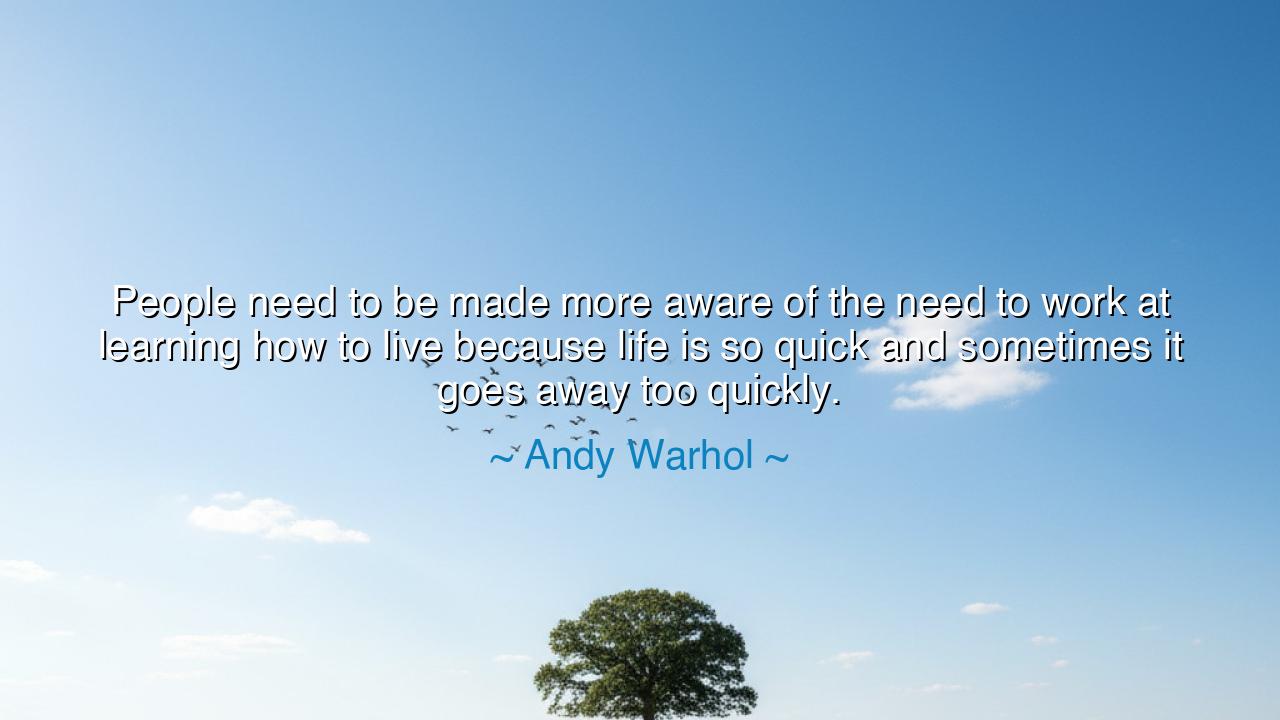
People need to be made more aware of the need to work at learning
People need to be made more aware of the need to work at learning how to live because life is so quick and sometimes it goes away too quickly.






“People need to be made more aware of the need to work at learning how to live because life is so quick and sometimes it goes away too quickly.” – Andy Warhol
In this quiet yet piercing reflection, Andy Warhol, the enigmatic artist of modern times, steps away from the bright colors and metallic surfaces of his art to reveal a truth far more profound than fame or image. He reminds us that living itself is an art, one that must be learned and practiced with care. To learn how to live is not to exist in routine or survival, but to understand the essence of time, purpose, and connection. Warhol, who witnessed the fleeting nature of beauty and the transient pulse of fame, knew deeply that life is quick, and if one does not learn to live deliberately, it slips away — quietly, invisibly, like paint drying on a forgotten canvas.
The origin of this thought comes from Warhol’s lifelong fascination with both life’s surface and its hidden depth. Amidst the glitter of celebrity and the clamor of modernity, he observed how people rushed through existence — chasing success, approval, and distractions — without pausing to reflect on what it means to truly live. His quote is a lament and a warning. The world, he implies, celebrates doing, producing, achieving — yet few are taught the sacred craft of being. We study how to build, to speak, to work, but not how to live wisely, how to savor, how to love, how to lose, or how to die with grace.
To work at learning how to live means to treat life as a discipline — a lifelong apprenticeship of the heart. The ancients understood this deeply. Socrates taught that “the unexamined life is not worth living,” for life without reflection is but motion without meaning. The Stoics of Rome — Marcus Aurelius, Seneca, Epictetus — all wrote not about the pursuit of wealth or status, but about the art of living: how to face adversity, how to cultivate joy, how to live in harmony with the world’s impermanence. They, too, knew that life passes swiftly, and that only those who learn to live consciously can truly say they have lived at all.
Consider the story of Anne Frank, whose short life burned brighter than most that last decades longer. In the confines of a hidden attic, surrounded by fear and uncertainty, she wrote not only of suffering but of beauty, hope, and the courage to live fully even as the shadow of death drew near. Her words — the reflections of a young girl — became lessons in the art of living. She had no time to learn by years, so she learned by awareness. She learned that to live is not simply to breathe, but to feel wonder even in darkness, to love in fear, to find light in confinement. Through her, we see Warhol’s truth illuminated: life is so quick, and yet, within even a brief moment, one can find eternity if one truly learns how to live.
Warhol’s words also carry a cry for awareness. “People need to be made more aware,” he says — for we are often asleep, lulled by speed, routine, and noise. Modern life rushes us forward, teaching us to measure time by schedules and achievements, rather than by depth or meaning. We scroll through days like pages of a book we never truly read. To learn how to live, therefore, is to awaken — to reclaim one’s attention, to look closely at the ordinary, to understand that each moment is fragile and sacred. Awareness transforms existence from a blur into a masterpiece.
Yet Warhol, the artist of repetition, also knew that learning to live is not a single act, but a continual practice. It must be renewed each day, just as an artist returns to the canvas again and again. The strokes may falter, the colors may change, but the act itself gives meaning. One must learn patience in sorrow, gratitude in joy, humility in success, and resilience in loss. These are the brushstrokes of a well-lived life. Without them, our days remain flat — beautiful perhaps in appearance, but hollow beneath the surface.
So let this be the lesson: do not wait to learn how to live until life is nearly gone. Begin now. Reflect each morning on what gives your day meaning; pause at dusk to ask what you have truly seen, felt, and learned. Speak to others not as shadows in passing, but as fellow travelers in the fleeting span of time. Live not as though you are rehearsing for tomorrow, but as though you are performing today’s final act.
For as Warhol reminds us, life is quick, and it can vanish before we have even understood its worth. The only way to hold it — not in duration, but in depth — is to work at the sacred craft of living. Learn to love deeply, to notice greatly, to forgive swiftly. Make your life not a hurried line, but a tapestry of intention. For when you learn how to live, even the briefest life becomes eternal.






AAdministratorAdministrator
Welcome, honored guests. Please leave a comment, we will respond soon